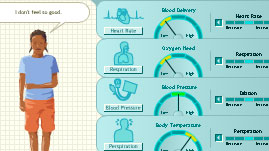Teachers' Domain - Digital Media for the Classroom and Professional Development
User: Preview

Source: Produced for Teachers' Domain
The amount of monitoring and adjusting that goes on in the human body at any given time is astounding. Thankfully, it's automatic, so you never have to think about it. In this interactive feature, however, every change in activity requires you to make adjustments in respiration or heart rate or energy delivery, and an adjustment to one system often changes the balance in some other system. See if you can do as good a job maintaining the harmony in this virtual body as your nervous system does in you.
Certainly you've noticed that on a hot day, especially when you're active, your skin perspires. This is your body's way of cooling itself. And when you run down the street to catch a bus, your body responds by increasing your heart rate and your breathing rate to supply your hardworking muscle cells with more oxygen. These bodily adjustments happen automatically, without your having to think about them. But if you're not at the controls, making sure your body gets enough oxygen and nutrients and doesn't overheat, then who or what is?
Biologists divide the nervous system into two parts: the somatic and the autonomic. The somatic system is responsible for all voluntary actions, like brushing your teeth or throwing a ball. The autonomic system handles all involuntary actions, including breathing, digesting, sweating, and the rhythmic beating of your heart.
The autonomic system can be broken down into two divisions: the parasympathetic system and the sympathetic system. The center of the parasympathetic system is a part of the brain near the top of the spinal cord called the medulla. The medulla communicates with various organs and glands through a large nerve called the vagus nerve and its many branches. The center of the sympathetic system is the middle portion of the spinal cord, in the thoracic and lumbar regions.
Although most organs are connected to both the parasympathetic and sympathetic systems, they do not receive the same type of information from the two systems. In fact, more often than not the two systems send opposite signals, though usually not at the same time. An organ that is stimulated to perform some function by the parasympathetic system will be inhibited to perform that function by the sympathetic system, and vice versa. For example, the parasympathetic system stimulates the stomach to secrete digestive juices, while the sympathetic inhibits such secretion; the sympathetic system causes arteries to dilate and the parasympathetic causes them to constrict. In general, the parasympathetic system stimulates organs that have relatively tranquil functions, including digestion, while the sympathetic system stimulates organs that have a more active function, especially those involved in "fight or flight" responses.
 Loading Standards
Loading Standards Teachers' Domain is proud to be a Pathways portal to the National Science Digital Library.
Teachers' Domain is proud to be a Pathways portal to the National Science Digital Library.
